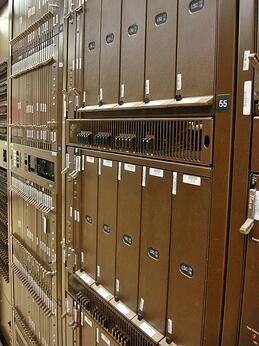Telecommunications Inside Plant: What is a Central Office?
 Today begins a recurring series on inside plant (ISP) telecommunications industry issues, equipment and central office organization, starting with a primer on one of the most important links in the call chain: the central office itself. Enjoy!
Today begins a recurring series on inside plant (ISP) telecommunications industry issues, equipment and central office organization, starting with a primer on one of the most important links in the call chain: the central office itself. Enjoy!
Once upon a time, more than forty years ago in most places in the U.S., when you picked up a landline telephone, rather than hear a dial tone, a human voice, an actual operator would ask you where and whom you wished to call. That person would manually connect your line to the one at your friend or family member’s location through a central switchboard. Today, a computer does this work automatically, but the location of the switching equipment remains the same: at a central office, or CO.
A central office is the physical location of where a call originates and ends.[1] These are built structures, and can take on a number of forms, from small, unmanned huts on the side of the road called remote terminals, to large, city-block sized buildings designed to blend into surrounding architecture. In smaller towns and municipalities, COs will often be “unmanned." This means a technician may visit the building once a day or once every other day, but not unless a trouble report arises, for maintenance, or if service must be turned up or disconnected.
Inside Your Local Telecommunications Central Office
So, what is inside a CO? Switching equipment, and lots and lots of “plugs or plug-ins," both in-use and spare, waiting to be utilized. Plugs are circuit packs—the brains, power sources and sometimes spacers, that work inside the routers and other equipment that allow us to connect one call to another. These devices range from a few inches and ounces in weight to large, heavy “blades” with multiple circuit panels within them that can cost thousands of dollars.
In addition to plugs that are in use, COs often also house backup or “spare” plugs waiting to be put into service in the event that another plug stops working. These delicate pieces of equipment must be stored properly (a topic we will take on in upcoming posts), and tracked and organized properly so that they are not lost in transfer between central offices and a telecom company’s warehouse, or mixed in with non-working plugs and put back into service as spares.
A Tidy CO is a Happy CO
While most places in the U.S. converted to automated telecom switching in the 1960s, one lone operator—Susan Glines—continued to manually connect calls in Bryant Pond, Maine until 1982, when an exchange still using a crank phone was finally converted.[2] Technology has also played a big part in the organization of now largely unmanned COs across the country. When it comes to keeping track of the multitude of plugs used and stored, viable and manufacturer discontinued, broken or awaiting transfer, conducting a thorough inventory with the aim of documenting equipment type, location and even special delineations like how many to keep on-hand in safety stock, is vital to running an efficient, cost-effective business. This is best done through a database-driven system that can be easily updated and referenced over time. Just as the days of the operator-manned switchboard are over, the days of the clipboard-and-spreadsheet inventory should be as well.
[1] http://en.wikipedia.org/wiki/Telephone_exchange#Manual_service_exchanges, [2] http://en.wikipedia.org/wiki/Switchboard_operator
Ready to get started with an asset management system geared toward the needs of inside plant (ISP) asset collection and data reconciliation for telecommunications? Click here.

Comments